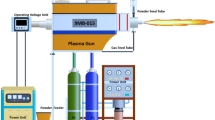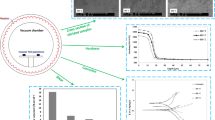Abstract
The effect of hydrogen embrittlement on the fracture toughness of a titanium alloy with different surface modifications was investigated. Disk- shaped compact- tension specimens were first coated with different .hard films and then hydrogen charged by an electrochemical method. Glow discharge optical spectrometry (GDOS), scanning electron microscopy (SEM), and x- ray diffractometry (XRD) were applied to analyze the surface characteristics. The results revealed that fracture toughness of the as- received titanium alloy decreased with the increase of hydrogen charging time. Fracture toughness of the alloy after plasma nitriding or ion implantation, which produced a TiN x layer, decreased as well, but to a lesser extent after cathodic charging. The best result obtained was for the alloy coated with a CrN film where fracture toughness was sustained even after hydrogen charging for 144 h. Obviously, the CrN film acted as a better barrier to retard hydrogen permeation, but it was at the sacrifice of the CrN film itself.
Similar content being viewed by others
References
D.A. Meyn, Effect of Hydrogen on Fracture and Inert-Environment Sustained Load Cracking Resistance of α-β Titanium Alloys,Metall. Trans., Vol 5, 1974, p 2405–2414
S.N. Sankaran, R.K. Herrmann, R.A. Outlaw, and R.K. Clark, Barrier-Layer Formation and Its Control during Hydrogen Permeation through Ti-24Al-11Nb Alloy,Metall. Trans. A, Vol 25, 1994, p 89–97
S.C. Lee, W.Y. Yo, and T.M Chen, Prevention of Hydrogen Degradation in Titanium by Deposition of TiN Thin Film,J. Mater. Eng. Perform., Vol 3 (No. 6), 1994, p 740–743
G.A. Lenning, CM. Craighead, and R.I. Jaffee, Constitution and Mechanical Properties of Titanium-Hydrogen Alloys,Hydrogen Damage, C.D. Beachem, Ed., American Society for Metals, 1979, p 100–109
G.Y. Gao and S.C. Dexter, Effect of Hydrogen on Creep Behavior of Ti-6A1-4V Alloy at Room Temperature,Metall. Trans. A, Vol 18, 1987,p1125–1130
J.P. Lucas, Hydrogen Effects on Fracture Toughness of Ti-6A1- 4V Determined by a Steadily Growing Stable Crack,Hydrogen Effects on Material, N.R. Moody and A.W. Thompson, Ed., TMS/AIME, 1990, p 871–880
J.P. Hirth and H.H. Johnson, Hydrogen Problems in Energy Related Technology,Corrosion-NACE, Vol 32 (No. 1), 1976,p3–15
G.T. Murray, Prevention of Hydrogen Embrittlement by Surface Films,Hydrogen Embrittlement, L. Raymond, Ed., ASTM, 1988, p 304–317
J.M. Chen and J.K. Wu, Diffusion through Copper-Plated AISI 4140 Steels,Corros. Sci., Vol 33, 1992, p 657–666
P. Bruzzoni and R. Garavaglia, Anodic Iron Oxide Films and Their Effect on the Hydrogen Permeation through Steel,Corros. Sci., Vol 33,1992, p 1797–1807
K.T. Kembaiyan, R.D. Doherty, R.P. Singh, and R. Verma, Ion Nitriding of Titanium and Ti-6A1-4V Alloy,Ion Nitriding and Ion Carburizing, T. Spalvins and W.L. Kovacs, Ed., ASM International, 1990, p 119–129
T.M. Muraleedharan and E.I. Meletis, Surface Modification of Pure Titanium and Ti-6A1-4V by Intensified Plasma Ion Nitriding,Thin Solid Films, Vol 221, 1992, p 104–113
A. Chen, J. Blanchard, S.H. Han, J.R. Conrad, R.A. Dodd, P. Fetherston, and F.J. Worzala, A Study of Nitrogen Ion-Implanted Ti-6A1-4V ELI by Plasma Source Ion Implantation at High Temperature,J. Mater. Eng. Perform., Vol 1 (No. 6), 1992, p 845–847
“Standard Test Method for Plane-Strain Fracture Toughness of Metallic Materials,” ASTM E 399–90
“Standard Practice for R-Curve Determination,” ASTM E 561–92a
D.N. Williams, The Hydrogen Embrittlement of Titanium Alloy,Hydrogen Damage, C.D. Beachem, Ed., American Society for Metals, 1979, p 185–190
J.E. Hack and G.R. Leverant, The Influence of Microstructure on the Susceptibility of Titanium Alloys to Internal Hydrogen Environment,Metall. Trans. A, Vol 13, 1982, p 1729–1738
Author information
Authors and Affiliations
Rights and permissions
About this article
Cite this article
Lee, S.C., Ho, W.Y., Huang, C.C. et al. Hydrogen embrittlement and fracture toughness of a titanium alloy with surface modification by hard coatings. JMEP 5, 64–70 (1996). https://doi.org/10.1007/BF02647271
Issue Date:
DOI: https://doi.org/10.1007/BF02647271




